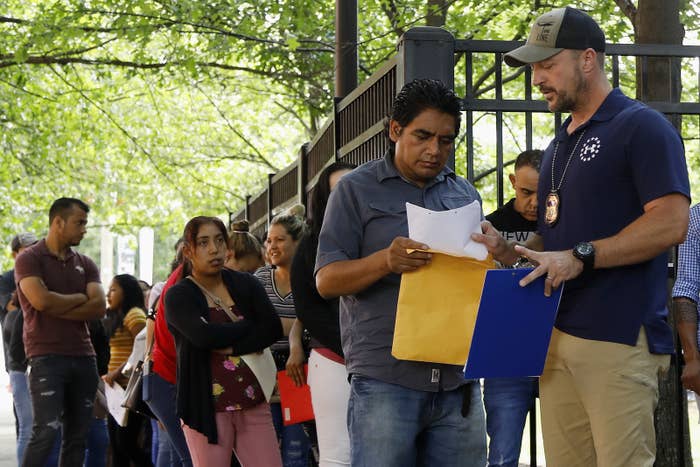
Immigration judges are criticizing a Trump administration plan to do away with in-person translation for initial deportation hearings, calling it “wrongheaded” and raising concerns about language issues, according to internal emails obtained by BuzzFeed News.
The Executive Office for Immigration Review, which administers the immigration courts under the Department of Justice, informed judges of the rollout in an email to everyone on staff on Thursday evening.
According to the plan, immigrants appearing in initial deportation hearings will receive a video instruction — with subtitles — of the nature of the courtroom proceedings, their rights, obligations, and other frequently asked questions. The deputy chief immigration judge who notified staffers of the plan, Mary Cheng, said it would increase efficiency.
The recordings are set to be made in Spanish initially, but will expand to 20 other commonly requested languages in the “near future” and will begin the week of July 15 in certain in courts, including in New York and Miami, according to the announcement released internally and obtained by BuzzFeed News.
As a result, in-person interpreters will no longer be present for any initial hearing if a translated recording is available.

Experts said that the lack of in-person translators in initial hearings could confuse those who first appear for their deportation cases, and it could create due process issues as they attempt to push back on allegations brought forth by the Department of Homeland Security. The largest group of recent arrivals is from Guatemala, and some of them do not speak Spanish but indigenous languages.
The rollout email was met with pushback by immigration judges — including three who responded in messages sent to all court staffers.
Stuart Karden, an immigration judge in Orlando, responded by saying that after immigrants are explained their rights, he confirms information, like their name, whether they understood the advisory and what their best language is.
Karden wrote that in the hearings he goes through whether the immigrant wants to go ahead with the case or if they have any avenues toward deportation relief. The judge noted that many in his court are from Guatemala and “it often turns out Spanish is not their best language.”
“Either way, this will take much, much longer than it does now as I’m able to go very quickly using a simultaneous translation with an in-person interpreter,” Karden said before asking if judges themselves had to play the video. “That seems like a total waste of time.”
If an assistant couldn’t do it, he added, “I’ll just be sitting on the bench twiddling my thumbs while the message plays.”
Robert Powell, an immigration judge in Texas, followed up to Karden’s email by saying it stated his situation “exactly,” adding that advising immigrants of their rights is just one part of the initial hearing and must be done individually.
“I think the entire premise of this plan is wrongheaded,” Powell wrote. “It will be disruptive to my court and definitely will not be a time saver.”
Margaret Burkhart, a judge in San Antonio, noted that immigrants who appear in her courtroom “cannot read Spanish at all or have limited abilities.”
“What about them? And I’m sure this will also be the case with the 20 other language speaking people she alludes to,” Burkhart wrote.
A DOJ spokesperson commented on the emails by saying immigration court officials have “received positive feedback from judges regarding the announcement that they are glad it reduces redundancies and appreciative this will make their jobs easier.”
Cheng told judges to schedule the hearings first with immigrants who have attorneys, then those without attorneys in case interpreters in other parts of the court are available for interpretation if needed. If that didn’t work, judges could use telephone interpreters.
The internal pushback is just the latest in a long line of conflicts between immigration judges and the Trump administration.
Since 2017, Trump officials have undertaken a monumental overhaul of the way immigration judges, which total around 400 across the US, work: placing quotas on the number of cases they should complete every year; ending their ability to indefinitely suspend certain cases; restricting when asylum can be granted; and pouring thousands of previously closed cases back into court dockets. In the meantime, the case backlog has jumped to more than 800,000 under the Trump administration and wait times have continued to skyrocket to hundreds of days.
The latest move, details of which were first reported by the San Francisco Chronicle, is another blow to immigrants appearing in court, said Sarah Pierce, an analyst at the Migration Policy Institute.
“I am not sure you could imagine a more blatant violation of due process than hampering an individual’s ability to communicate with the court,” she said. “During these initial hearings, migrants are supposed to plead to DHS’s accusations and let the court know what sort of relief (if any) they intend to apply. It is laughable to think a prerecorded video, in the place of an interpreter, will increase the efficiency of these proceedings.”
